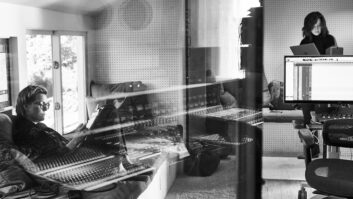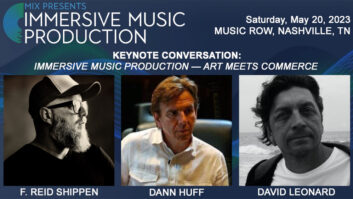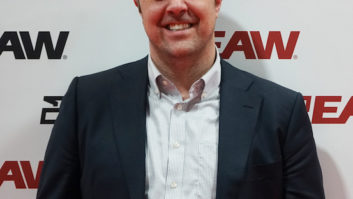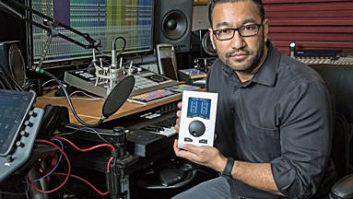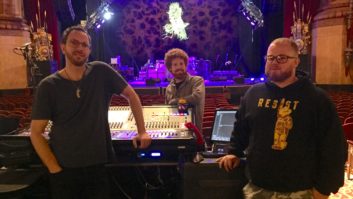Twenty years, nine full-length albums and thousands of miles later, Amy Ray and Emily Saliers agree that being in the Indigo Girls is still not a job and sure beats having one. “Oh my God, I’m so thankful every day!” says Saliers. “Before we go onstage, after we leave the stage, all the time! It’s an honor and privilege to work with Amy, for all the people we’ve met who have mentored and inspired us, a million things have happened for us that I can’t believe. We work hard, we’ve made sacrifices, it’s hard and uncomfortable to be in the public eye sometimes, but we’ve been lucky to have a network and resources for our social activism, to get people together on issues. So as much as musically, for our activism, I’m thankful for what this career has brought to us. It’s astounding.”
Over the course of two decades, the Atlanta-based singer/songwriters have become best known for two-part harmonies layered over their Martin guitars. Interspersed between these melodies, however, they’ve enjoyed the luxury of experimentation, both in the studio and in concert. They’ve expanded their instrumental vocabulary to include a variety of instruments such as mandolin, harmonica, electric guitar, banjo and bouzouki. There was a solo album, Stag, for Ray in 2001, and even a walk on the harder side of musical genres with their previous release, the 1999 Come on Now Social. But by the time the duo began tracking that disc, Ray already knew that she wanted to return to their signature acoustic sound. What she didn’t expect was that it would take until 2002 and the release of their latest album, Become You.
“I’m sort of a split personality,” she says. “I’ve been thinking about this for five years. I’m happy to do both kinds of records, but in the back of my mind, I knew I wanted to go back to basics. Emily wasn’t into it for a while, but I was constantly bothering her! When she’s ready, she’s ready. I wanted to do a no drums or anything album, like [Springsteen’s] Nebraska, and she wasn’t interested. But I love the band we play with, so it’s not like I had to compromise my vision. It’s the rootsy record I wanted, with the beat and bass parts that Emily wants.”
Foremost on the priority list for making Become You was that the musicians track live, together. Recording began in September 2001, at Tree Sound Studio in Norcross, Ga., with producer Peter Collins, who had worked with the Indigo Girls on the 1992 Rites Of Passage and in 1994 on Swamp Ophelia. “Peter was originally a folk singer,” says Saliers. “He has a good musical ear and is a really good friend of ours. When we were ready to start recording, he gave us a friendly call to see what was going on, and Amy said, ‘Let’s ask him to come to rehearsal to hear the songs and give us some guidance,’ because we sometimes need a mediator. We decided to have him come in for two days, and he suggested musical hooks here, accordion there, Latin beat there — they were great structural and musical ideas. Amy and I said, ‘We can’t make this record without Peter,’ so we begged him to stay.”
Ray also suggested another friend, Glenn Matullo, to engineer. “He’s one of my favorite acoustic engineers,” she says. “I heard a lot of the stuff he had done in Atlanta and my choice of him was based on the type of record this was going to be. His work with Shawn Mullins, his use of compression on vocals, his decisions on how to mike things — he gets the truest sound of instruments of any engineer I’ve ever worked with, and he’s very fast. He doesn’t waste time or kill the vibe.”
Matullo, a graduate of Ohio University who relocated to Atlanta in 1992, worked in audio production at CNN prior to becoming an assistant engineer at Nickel and Dime Studio. During his five-year stay there, he established contacts in what was then a thriving acoustic scene, and assisted on an Indigo Girls project, thus beginning his relationship with Saliers and Ray. With his reputation cemented, Matullo opened Orphan Studio, and has since worked with Mullins on all his albums, as well as with Collective Soul, Josh Joplin, Michelle Malone and numerous Atlanta-based artists. He also engineered Stag, Ray’s independent project. At that time, she was already talking about making an acoustic Indigo Girls record, and, he says, “We met, I gave them my two cents about how I could help out, and we took it from there.”
With Collins producing and Bob Clear-mountain mixing the finished product, Matullo says that his role in making the album was “giving [Saliers and Ray] what they wanted and trying to make it easy for them to accomplish what they wanted to do. The creativity is the producer’s job; the technical part is up to the engineer. It’s making something happen fast so as not to lose the momentum, and putting all the technical pieces together. The setup of the record was pretty huge, and making it logistically happen is the job of the engineer and assistant engineer — Robert Hannon. The way we started recording, we couldn’t have gone anywhere but Tree Sound because it’s big, open and everyone can see each other. We set up the entire band and that can be overwhelming, so it says a lot for the studio and assistants, in general, that they made everything work for us.”
While making an acoustic record offers some ease compared to setting up and capturing a multi-instrument, high-volume rock band, the flip side is that tracking is more precise: Flaws and errors can’t be concealed under loud guitar solos. Matullo agrees with the premise, but says, “With the Girls, it definitely didn’t make a difference because they’re such great players that they make it easy on the engineer. I just had to get the right mic and make sure it sounded like what they were playing. As long as you’re in a great studio, the job is simply to capture the pure sound. This is a very stripped-down record, and I haven’t done one like this in a long time. It was two acoustic guitars and a band and not a lot of overdubs, but that was the goal going into it. We wanted to make sure that everything we recorded had nothing wrong, because it would all be heard.”
Although Matullo makes it sounds easy, Saliers counters that making records “always feels like work. It takes a lot of energy; you want every take to be the best it can be, and sometimes parts take forever. It was getting cold, so throat issues came up that you can’t predict. We were working out arrangements. It takes a lot of mental energy, and working quickly made it more stressful for me, but it was good for Amy because she’d done Stag that way. I had more of an adjustment. I was used to working on a record for four or five months, so I felt I was rushing my songs [over seven weeks]. Now I’m glad we did it quickly, because after it was done, it was a relief.”
Ray found that Peter Collins had “loosened up in some ways as far as letting some things go that he may not think are perfect. Not the performances — he’s always forgiving about that — but in production ideas. He’s pretty steadfast and consistent because he’s always been a hook man. One thing that was different is that we used Pro Tools, which we’d not done with Peter before. It didn’t change his approach, although maybe he’s more willing to comp a vocal because it’s easier now, whereas before…Emily was always more into that than Peter. So now it’s quick, and everyone gets what they want. I did a lot of live vocals on this record. I loosened up and wanted to capture the moment. It was a low-budget album, and it was more important to capture the vibe than the perfect pitch. In the past, I might have been too much of a stickler and sterilized and took the life out of the songs sometimes.”
To capture the essence and clarity of the vocals and acoustic guitars, Matullo relied on Neumann and Royer microphones. With Ray, he used two Neumann U67s and a Royer 121. “The ribbon microphone is very old technology dating back to the jazz singers of the 1920s and 1930s,” he says, “and it’s making a comeback in the digital arena of making records because it’s very warm and natural-sounding, and great for acoustic recordings. Amy is a big fan of the Royer for her vocals. With Emily, again I used the U67 or the newer Neumann TLM 170 and vintage U47. My mic pre and compressor of choice on every song was the Avalon 737. That stayed consistent, and I just switched out the microphones.
“I don’t always use the same piece of gear for this specific instrument, but for acoustic guitars, I’m a huge fan of the Neumann KM184 or KM84, the vintage version. They’re very real-sounding and capture the guitar really well, especially in instances where you’re doing live guitar and vocal. They’re smaller mics and very tight in the pickup pattern, so you don’t get a lot of vocal bleed on guitar music. It’s a smaller diaphragm mic. For larger diaphragms, I like the U67 or 149. As far as outgear to go with those mics, I used the Focusrite ISA 215 mic pre. The compressor is very important for acoustic guitar, and I used a Distressor.”
Matullo believes that Become You could not have been made without Pro Tools. “With today’s technology, as long as you use good mics and pre’s and warm-sounding instruments and gear, there’s no reason not to use [Pro Tools],” he says. “It makes the job easier and faster, and you don’t have to throw up that twelfth roll of tape to do overdubs. We set up everybody live — everybody — and we kept a lot of those tracks. We’d go through the songs and record everything, literally. We couldn’t have done that with tape — we would have run out! Peter is a big fan of happy accidents, and he didn’t want to miss a note, so that if there were amazing takes, we’d have them. Of course, we did some fixes, but the basic recording of this album was all done live.”
